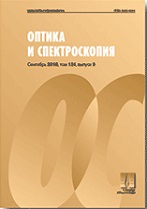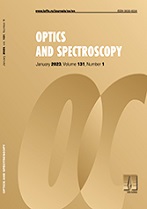|
This article is cited in 4 scientific papers (total in 4 papers)
Spectroscopy and physics of atoms and molecules
Studying the dielectric properties of the curcubituril cavity on the basis of the solvatochromic effect of styryl dye upon the formation of an inclusion complex
A. S. Stepkoa, N. A. Lobovaab, P. V. Lebedev-Stepanovac
a Photochemistry Centre, Russian Academy of Sciences, Moscow
b Moscow Institute of Physics and Technology (State University), Dolgoprudny, Moscow Region
c National Engineering Physics Institute "MEPhI", Moscow
Abstract:
A new approach to the theoretical evaluation of the local dielectric properties of media that contain an organic dye acting as a nanoprobe is proposed. The method is checked so as to evaluate the dielectric properties of the host molecule in a supramolecular inclusion complex from the experimentally measured shift of the optical absorption spectrum of the guest molecules (dye) after the complex formation. Using the Onsager–Liptay model, the dielectric properties of the cucurbit[7]uril cavity was theoretically estimated by analyzing the experimentally measured shift of the absorption spectrum of 1-(3-ammoniopropyl)-4-[(E)-2-(3,4-dimethoxyphenyl)-ethenyl]-pyridinium dication of the dye after it forms a complex with cucurbit[7]uril in an aqueous solution. To parameterize the Onsager–Liptay equation, the positions of the absorption spectral maxima of the dye under study were experimentally measured in the following solvents with known dielectric and optical properties: methanol, ethanol, 1-propanol, 1-butanol, and water. When calculating molecular structures, dipole moments of the ground and excited states, and polarizability, the TD-DFT quantum chemical method with the CAM-B3LYP functional in the 6-311G(d,p) basis set was used within the Gamess (United States) software package. The obtained theoretical value of the effective dielectric permittivity of the cavity (about 13) is in good agreement with the published value.
Received: 11.05.2018
Revised: 17.09.2018
Accepted: 04.12.2018
Citation:
A. S. Stepko, N. A. Lobova, P. V. Lebedev-Stepanov, “Studying the dielectric properties of the curcubituril cavity on the basis of the solvatochromic effect of styryl dye upon the formation of an inclusion complex”, Optics and Spectroscopy, 126:4 (2019), 391–397; Optics and Spectroscopy, 126:4 (2019), 309–315
Linking options:
https://www.mathnet.ru/eng/os728 https://www.mathnet.ru/eng/os/v126/i4/p391
|


| Statistics & downloads: |
| Abstract page: | 20 |
|





 Contact us:
Contact us: Terms of Use
Terms of Use
 Registration to the website
Registration to the website Logotypes
Logotypes







 Citation in format
Citation in format 
